Home › Home vegetable garden › Easy vegetables to grow
Five Easy Vegetables to Grow
Which are easy vegetables to grow? When I first start growing my own vegetables I remember being faced with a bewildering range of possible choices.
So much so that a friend of mine actually failed to plant anything in the first season because she was so confused!
Don't let this happen to you.
Instead, concentrate at first on vegetables that are easy to grow.
That way your early success will build up your confidence until you are ready to try something more challenging.
I can guarantee that all the following vegetables are virtually foolproof, requiring only a reasonably well prepared site and regular watering and weeding.
Easy Vegetables to Grow Number 1: Runner Beans
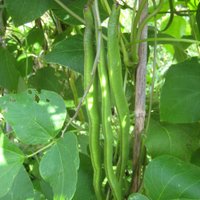
Runner beans are definitely easy vegetables to grow, probably the easiest of all!
They produce good crops with very little input from you, the gardener.
What's more, they are very decorative plants and can be incorporated into your flower border.
Site preparation
Runner beans will grow in any reasonable soil and will also tolerate a degree of shade making them very easy to fit into spots where other vegetables won't grow.
Sowing and supporting
Runner beans can be sown directly in the ground in early to mid May, spacing the plants 23-30cm (9-12in) apart.
They are quite vigorous climbers so you will need to provide some sort of support for them. Put the supports in place before sowing.
In a small garden you can plant a single row at the foot of a trellis or netting-covered fence or wall.
If you have more space use two rows of 2.4m (8ft) canes, pushed into the ground at 30cm (12in) intervals.
Space the rows 60cm (2ft) apart and tie each cane to its opposite neighbour. Secure by running nylon twine through the top of the supports and pegging into the ground at each end.
For a more decorative effect, create wigwams by pushing a circle of four to six canes into the ground. Space the canes 45-60cm (18-24in) apart, and tie the tops together with twine.
Plant the beans at the foot of each cane watering in well, and, if possible, mulching with garden compost to retain water.
Routine care
Hoe to remove weeds and keep well watered, especially when the plants are flowering.
Harvesting
Start picking your beans as soon as they are long enough to use and pick regularly to encourage plants to keep cropping.
Easy Vegetables to Grow Number 2: Courgettes or Zucchini
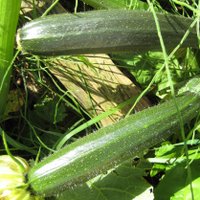
Courgettes, also known as zucchini, are another great favourite, rewarding you with good crops for little effort.
They are not hardy, so in cooler regions are best started off either indoors, or outdoors with some protection.
Please don't let this put you off because they are still very easy vegetables to grow.
Site preparation
Courgettes, or zucchini, really appreciate rich fertile soil with a high organic content so try to incorporate lots of garden compost into the ground.
If you want to go a step further, you can prepare the site in winter by digging a good sized hole, filling it with garden compost, and covering with a mound of soil.
In spring, plant your courgettes or zucchini directly on top of this - they will love you for it!
Sowing and transplanting
To lessen the chance of seeds rotting, sow them on their edges. Sow individual seeds indoors in small pots on a sunny windowsill in mid to late April.
Harden off the young plants before transplanting to their cropping positions in late May to mid June after all danger of frost has passed.
Alternatively, plant the seeds outside in their cropping positions in late May to early June and cover with clear, cut-off plastic drinks bottles to afford them some protection at the start.
Courgettes or zucchini need plenty of growing space so allow 60cm (2ft) between plants in each direction.
Routine care
Keep plants watered and apply a liquid tomato feed every fortnight once the fruits start to develop.
Harvesting
Pick the courgettes or zucchini as soon as they are about 15cm (6in) long and keep picking regularly to encourage more fruiting.
Easy Vegetables to Grow Number 3: Swiss Chard
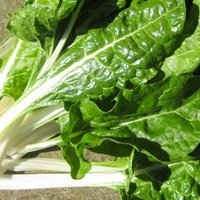
I first became aquainted with Swiss Chard many, many years ago in Italy.
Since then I have grown it regularly.
It is not usually available in the shops as it doesn't store and travel well but it is very easy to grow and has a long cropping season, especially if you make two sowings.
Site preparation
Chard is very undemanding and will grow almost anywhere but adding garden compost or other organic matter to the soil will give you a better crop. Swiss chard also tolerates a little shade.
Sowing
Swiss chard is quite hardy so it can be sown outdoors from April onwards. For the longest harvesting period sow in two batches, one in April and one in mid July.
Either sow thinly in shallow drills set 30cm (12in) apart, and then thin out the seedlings to 20-30cm (8-12in) apart, or sow groups of two or three seeds at these spacings and remove the weakest seedlings from each group.
Routine care
Little special care is required beyond keeping the weeds down and watering in dry spells.
Harvesting
Start harvesting as soon as the leaves are big enough to use. Pull off a few leaves from each plant, leaving the rest to grow.
Early sowings should provide a harvest from July to October, whilst July sowings will keep going into the winter.
Although they will stop growing, and even die down, in very cold periods, they will start to grow again in spring giving you a final flush of leaves before they run to seed.
Easy Vegetables to Grow Number 4: Mixed Salad Leaves
Go into any supermarket these days and you will find a range of pre packaged mixed salad leaves.
But why pay a high price for a few ounces of salad when it is so easy to grow your own?
Most seed companies these days provide a range of different mixtures for you to try.
Site preparation
Salad leaves grow best in rich, fertile soil so incorporate lots of well rotted garden compost into your salad bed.
These crops don't like freshly manured soil, but if you have a site that was manured for a different crop in the previous season, this would be ideal.
You can also grow them on the patio in large troughs or containers filled with multi purpose compost.
Sowing
For a constant supply make successive sowings every fortnight from late March to August.
Sow the seed in a weed free bed by scattering finely over the surface in blocks. Thin the seedlings to 2.5-5cm (1-2in).
Routine care
Pick out any weeds that appear and water regularly.
Harvesting
Pick individual leaves as soon as they are big enough to use, leaving the rest to grow on.
You should be able to make several cuttings before the plants become exhausted or run to seed.
Once this happens move on to the next batch that you planted and so on.
Easy Vegetables to Grow Number 5: Leeks
Leeks are one of the best easy winter vegetables to grow, and, being hardy, there are no storage problems - you just leave them in the ground over winter, picking them as needed.
You can also grow pencil leeks to use as baby veg and in salads in the summer.
Site preparation
Choose a sheltered sunny spot and dig in plenty of well rotted compost or manure a couple of weeks before sowing.
Sowing
Sow outside in a shallow drill in mid March to April. After germination, thin out the seedlings to 2.5cm (1in) apart and leave to grow on.
Transplanting
When the seedlings reach 15-20cm (6-8in) they are ready to transplant.
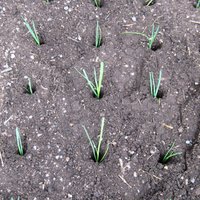
Firm down the soil and make individual holes, 10-15cm (4-6in) deep, using a dibber or trowel handle.
The holes need to be 15cm (6in) apart.
Carefully lift the seedlings and drop one into each hole so that the roots touch the bottom.
The image to the right shows newly transplanted leek seedlings.
If you like you can trim the roots by up to two thirds, and the leaves by up to one half before you transplant.
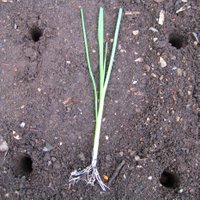
Although this is regarded as rather old fashioned advice, I like to do it for two reasons.
Firstly, I find it is easier to insert the trimmed roots into the hole, and, secondly, the leaves don't flop and blow about so much on my rather exposed site.
Whichever method you choose, don't backfill the holes with soil or firm down.
Instead, gently fill each hole with water to wash soil around the roots.
Routine care
Keep weed free by hoeing, and water in dry periods.
Harvesting
Start lifting the leeks as soon as they are big enough to use. You only need to pull as many as you need each time - the rest can stay in the ground until you need them.
Related Pages
More tips on vegetable growing can be found at creating a successful home vegetable garden.
If you are thinking of growing your vegetables in raised beds, the information at planning a raised bed vegetable garden is for you.
Alternatively you might like to try growing your vegetables the 'no dig' way. It's easy and offers many benefits to the time pressed gardener. Secrets of a successful no dig vegetable garden shows you how.
And if you've always been put off growing your own potatoes because you thought it was too complicated, how to grow potatoes demystifies the process. It's not nearly as difficult as you might think, so do give it a go!
Home › Home vegetable garden › Easy vegetables to grow
